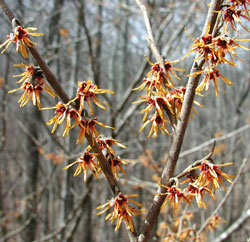Resource Library
Plant of the Week: Witch Hazel
The University of Arkansas System Division of Agriculture does not promote, support or recommend plants featured in "Plant of the Week." Please consult your local Extension office for plants suitable for your region.
Plant of the Week
Witch Hazel
Latin: Hamamelis vernalis

The water well is in, and it's a good one making more than 80 gallons a minute.
The well in question is at my son's and daughter-in-law's nursery in the Arkansas River Valley community of Lamar. Unlike their first well that was a dry hole, this well was dowsed by a water witch.
What makes this an intriguing story is that the two holes stand only about 25 feet apart and were both sunk to the same depth.
Dowsers, water witches or, water wigglers as Ozark hill people sometimes call them, have their own favorite techniques. Jeff's dowser used brass rods, often preferred today because there's no need to seek freshly cut twigs from a favorite tree. But some of the most highly revered witching sticks come from forked branches cut from the Ozark witch hazel, Hamamelis vernalis.
Though philologists like to point out that the "witch" in witch hazel probably came from an Anglo-Saxon word "wicken," which means to bend, it still refers to the ancient practice of finding water by means of a divining rod. In Europe, the hazel (Corylus colurna) was the wood of choice for dowsing while New World immigrants made do with a look-alike plant they called "witch hazel."
The Ozark or vernal witch hazel is a native, deciduous large shrub or small tree found along water courses throughout the Ozarks and Ouachitas in Arkansas. It grows about 15 feet tall and wide with branches arising near ground level from a short trunk. The coarse-textured leaves are 4 to 5 inches long.
The fragrant, inch-wide yellow or mahogany colored flowers appear in February after the coldest days of winter are past. The petals are strap shaped and open on warm days, closing at night and on cold days.
Flowers are followed by a half-inch long woody capsule containing three to five shiny black seeds. As these capsules dry, the seed are explosively expelled up to 30 feet from the original tree.
The choice of twigs to use in divining seems to be as much a question of personal preference and plant geography as anything. In addition to both kinds of witch hazel - peach, wild cherry and willow all have their advocates. As long as the switch is forked, about 3 feet long and supple, it will work for those with "the touch."
Dowsers - the term used in my family instead of the more superstitious sounding "water witch" - perform their magic by grasping the slender branched forks tightly in each hand, extending the butt of the stick out in front of them. Then, by walking across the ground and watching for the telltale twitch and bob of the end of the stick, they identify a location for the well.
Not only can a good dowser identify the location to dig the well, they can tell you at what depth you will encounter water. To accomplish this feat most seem to locate the well in the location with the strongest pull on the stick. Then, by pacing off in any direction from that point, they count paces until they no longer feel a tug on the stick. This radius of the circle where the tug stops is equal to the depth of the water.
The effectiveness of water witching elicits strong opinions. The scientific community, the National Ground Water Association and the U.S. Geological Survey all consider dowsing useless in finding water. Dowsers claim amazing success approaching 99 percent.
Scientific studies on dowsing are hard to come by but one out of Africa - a study critics label as hopelessly flawed scientifically - showed that 96 percent of the 691 dowsed wells dug in Sri Lanka produced water. Unfortunately, researchers didn't have a non-dowsed set of wells as a comparison group to see how common water was in the subterranean strata.
For myself, I'll keep an open mind. I hope that there are still unresolved mysteries in the universe. Maybe dowsing is one of these.
By: Gerald Klingaman, retired
Extension Horticulturist - Ornamentals
Extension News - September 15, 2006
The University of Arkansas System Division of Agriculture does not maintain lists of retail outlets where these plants can be purchased. Please check your local nursery or other retail outlets to ask about the availability of these plants for your growing area.